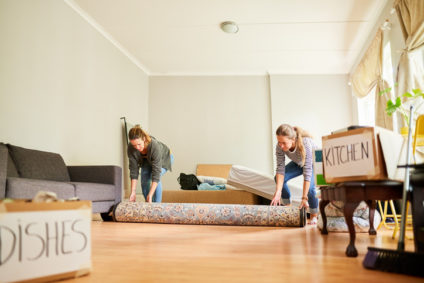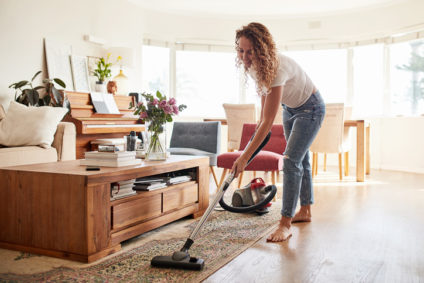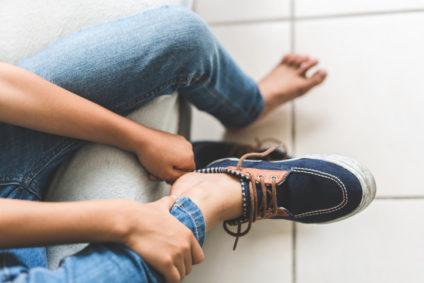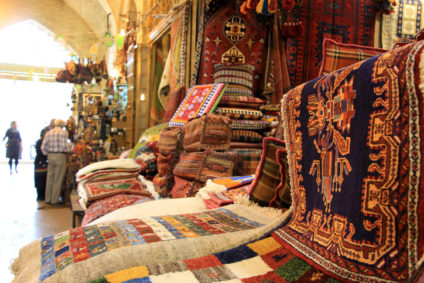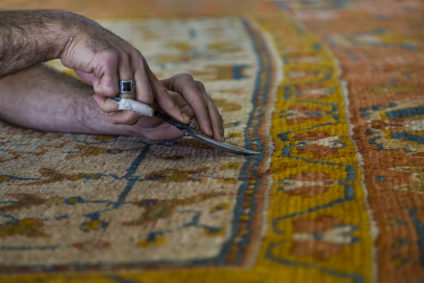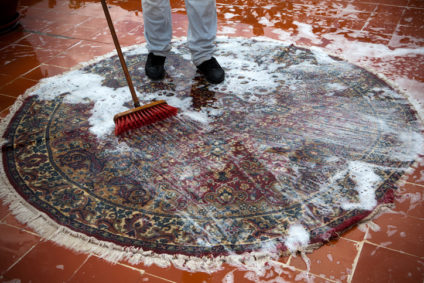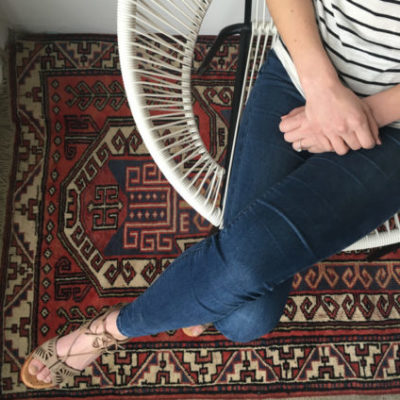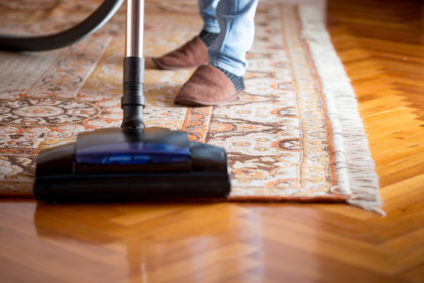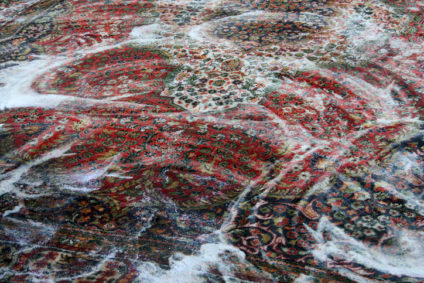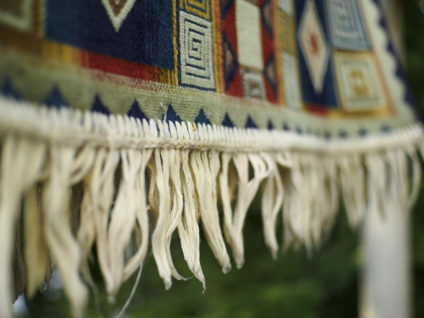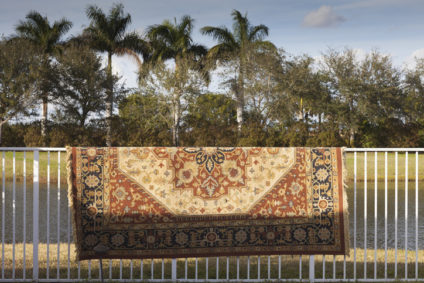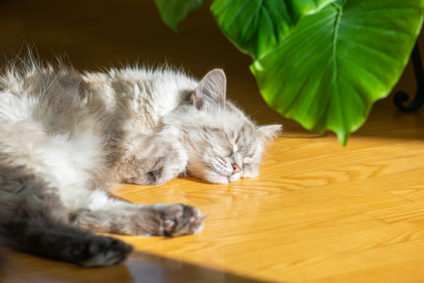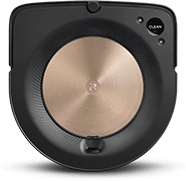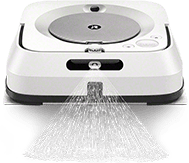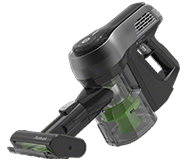11 Best DIY Persian Rug Cleaning Tips
We’re almost scared to touch our Persian rugs, right?
We know their colors can easily bleed. We know they’re often made of silk or wool, which is easy to damage, requires special cleaning solutions, and has to be dried completely… and fast.
It’s why most of us immediately opt for a professional rug cleaning service. But that may cost hundreds, and maybe you just don’t need that deep a clean.
In that case, here’s how to DIY Persian rug cleaning.
1. Always Check the Care Label on Your Persian Rug 
Not all Persian rugs will have a care label, especially if they were handmade. But, if your rug does have a care label, you absolutely should follow the care instructions.
Manufacturers know their rugs and what they can tolerate best.
Following their instructions often means keeping the colors and wool fibers intact and extending the life of your rug.
2. Remove Dirt & Dust: Vacuum, Sweep, and Shake
Shaking your rug outside is a very traditional way to clean a rug, but it’s one of the most effective ways between deeper cleans.
It’s also one of the safest ways to preserve your rug.
The fibers of a Persian rug are often silk, meaning they’re pretty delicate and sensitive to rigorous and regular agitation. In other words, the gentler you are, the longer your rug will last.
So shaking between vacuums or deep cleans helps to remove the dirt from deep within your rug without pulling at the rug fibers. So pick up your rug and shake it!
It might sound like a strange idea to sweep a rug, but you can pull up quite a bit of dust and debris – especially the larger chunks.
Simply start at one end of the carpet and swipe along in very small but fast strokes. Sometimes this works better with a hand broom.
Vacuuming your rug can take up debris from deeper within the carpet, or even prevent the debris from burying deeper into the rug.
In fact, if your rug is in a high-traffic area, you should vacuum it fairly often in order to keep that debris from getting too deep into the rug. Weekly is generally a good frequency for vacuuming a rug.
There is a caveat to that: you shouldn’t use a vacuum with a rotating brush or beater bar, as it will agitate the fibers far beyond what they should handle. The constant raking is very likely to cause damage, whether you can see it right away or not. And rug repair is not a fun task.
(Please note that our Roomba® robot vacuums all use beater brushes, so it’s best to create a Keep Out Zone for Persian rugs with our iRobot Home App.)
Looking to stay organized? Add rug cleaning to your weekly house cleaning checklist.
A House Cleaning Checklist for Each Room, by Day, Week, and Month
3. Prevent Carpet Cleaning: Remove Your Shoes
While it’s not part of every culture to remove your shoes when entering a home in the United States, it’s very much built into the habits of many others around the world.
Removing your shoes in the home stems back thousands of years, and ties to religious practices, signs of respect in the ancient world, and dining throughout the ancient world- when many would sit on the floor and eat at low tables.
Even in those ancient times, they understood that feet were often dirty, and it shouldn’t come near your food or be tracked into your home.
Today, that still rings true, as we walk all over pesticide-filled grass, pet urine on city streets, spit and tossed bubblegum, and all manner of dirt and germs.
It’s not just that it’s a good practice for keeping your home clean. It’s also a way to keep your rugs fresher for longer.
Those fibers trap dirt and debris (and smells) a lot easier than you may realize. Simply removing your shoes can drastically reduce the amount of dirt that lands in your rug.
4. Pick the Right Cleaning Solution
Many of you might jump straight for the bottle on the shelf labeled “carpet cleaner” or some iteration of such. And why wouldn’t you, right?
After all, it says it’s specifically designed for cleaning carpet, or rug cleaning. But sadly, a lot of those cleaners aren’t designed to care for delicate fibers like wool or silk.
They include a lot of chemicals, and a lot of scents to cover up the musty smells and odors still trapped in your fabrics.
Worse, they’re often so acidic that they cause the fibers to deteriorate. At best, they simply drain the color of your rug. You may not notice it at first, but over time, your rug will fade and dull.
Why are Persian rugs so delicate you can’t use just any cleaner?
Authentic, traditional Persian wool rugs are made from sheep’s wool. The fibers are washed and hand-dyed using natural ingredients.
Now, often we don’t know what the blanket term “natural ingredients” really means, but in the case of Persian rugs, it’s usually insect (strange, but true) and plants, sometimes even spices.
Those colors aren’t exactly going to stick around if you use everyday soap on them.
(p.s… this is also part of the reason Persian rugs are so expensive. Besides this, Persian rugs are woven by hand, and the larger rugs may need 3 or 4 people working on them, and may still take months to complete.)
Another rug that gets smelly from being wet: JUTE! Check out our blog to learn why:
Why your Persian rug still smells after you’ve cleaned it
You can try to clean a rug again and again, with multiple deodorizers and cleaners… You can send it to a professional cleaning service, and it still might smell, regardless of whether it looks clean.
The reason for this is that the dirt and soil in your rug is generally on the surface.
Sure, the debris can get trapped pretty deep within the fibers, but that’s still somewhat on the surface of the rug.
Odors aren’t just trapped within the fibers. They rest in the base of the rug, with the knots and the matting.
Most carpet cleaning solutions, and even the professional cleaners, don’t concentrate on that lower part of the rug – the foundation. It’s just about getting the surface looking clean.
Even if you soak the rug to get to that foundation, your rug is still sitting in that smelly pool and all the smelly materials have nowhere to go. So they continue to stick to the rug. Really, the only way around this (if your rug is smelly), is to commence a cycle of soaking and draining, soaking and draining.
Rinse the cleaner through the rug again and again until the water is somewhat clear after filtering all the way through.
Following that, you have to dry the rug as quickly as possible. Generally, the best way to do so is by hanging it in a dry, warm space with fans and maybe a humidifier.
The right cleaning solution for a Persian Rug
The answer isn’t all that easy. It’s not just… here’s this one perfect cleaner and that’s all you should use.
Really, there are a few options.
One of them is white vinegar diluted with water.
Not baking soda and vinegar. Baking soda is not a great option for cleaning a carpet because, though it’s extremely fine, it’s still gritty and will damage the natural fibers.
The chalkiness also settles deep within the rug, leaving it caked and chalky without a real way to get it out.
Vinegar, on the other hand, is mildly acidic (which is good for Persian or Oriental rug cleaning) and effective at removing odors that get trapped in wool (very easily, we might add).
Castille soap is another great cleaner for wool and silk rugs.
Castille soap is fairly mild, and Ph neutral, yet a very effective cleaning agent, making it one of the best cleaners for delicate Persian rugs.
Despite what you might think, you don’t actually need a ton of suds and soaps to clean a rug. Foaming agents aren’t necessarily cleaning your rug. In fact, if it’s an alkaline based cleaner (like an enzyme cleaner) it’ll actually damage your rug by draining the colors (so will hot or even warm water).
While Ph cleaners are a safe way to go, you get an even better clean with an acidic cleaner (and cold water).
5. Clean Up Spills & Stains Right Away
Naturally, any time a mess sits on your rug for a bit, the harder it’s going to be to get out. It’ll settle deeper into the fibers until you can’t get it out with a simple spot clean. (Stain removal is not easy.)
That’s why it’s imperative that you try to soak up that mess as soon as it lands on your rug.
The best way to do this is by:
- Applying a clean, dry rag or paper towel, and pressing it into the spill very gently with the palm of your hand. You’ll see that a lot of the stain will come out of the rug right away.
- Add club soda to the spot. Let it soak in and stop fizzing.
- With another clean, dry rag, press into the spot with the palm of your hand to take up the excess moisture.
- For a more heavily soiled spot, you can lay another dry, clean towel down and lay a heavy book on top of it for the stain to soak into the rag. You can leave it there for a few hours.
- If you’ve been able to take up the stain with these simple steps, you want to quickly dry your rug. You can use a hairdryer on a low setting or a fan to help with this.
For deeper set stains or spills like wine or mustard that you can’t get up with club soda, there’s a unique mix you can use to spot clean stains.
- Use a clean, dry rag to soak up as much of the stain as you can.
- Gently scoop room temperature or cold water onto the stain.
- Use a spoon to scoop up the water from the carpet (into a different bowl than the clean water). You’ll see that you’re able to get up a lot of the discoloration from this alone.
- Combine water and an acidic or ph neutral cleaner, and apply lightly to the area with a clean (preferably new) sponge or rag.
- Soak up as much of the remaining liquid as you can with a clean rag.
- Dry your rug with fans or a hairdryer on a low setting.
Curious what professional rug cleaning looks like? Check out our blog:
Oriental Rug Cleaning – Without the Cost of a Professional Clean
6. Care for the Fringe
Rug fringe is one of those areas that are often neglected during a clean. Mostly because you can’t really vacuum them, but they just happen to be white on top of it all.
When they’re dirty or stained, it just stands out more and makes your entire rug look dingier.
You actually have a bit more liberty when it comes to cleaning fringe, vs the rest of the rug, because it doesn’t possess any color.
If you’re just cleaning the standard dirt out of fringe:
Use a mild detergent – acidic or Ph neutral – and a short bristled hand brush (like a shoe brush) to gently scrub the fringes.
For stains, such as if your rug colors have bled into the fringe from past cleanings:
This is about the only time you’d ever use an alkaline cleaner, such as an oxy-based cleaner, bleach, or hydrogen peroxide.
Those agents cause bleeding when used on your rug, but on stained fringe they can help bleach them back to white.
7. Rinse Well When Hand Washing
If you are hand washing your rug, make sure to truly rinse out your rug from all the cleaner and detergent you use.
When you leave soap on a rug, it can weaken the fibers and the colors on the fibers of the rug. If that’s not bad enough, the soap can actually attract dirt and make it look dingier over time.
Looking for the best way to clean the other rugs in your home? Check out our blog:
8. Dry Fast (The most important step in the area rug cleaning process)
You know that awful smell of wet dog? Well, how about wet sheep?
Most Persian rugs are made of sheep’s wool, and you just can’t keep that wet. Not just because it can make the fibers of your rug grainy and cause color bleeding, but because it’ll make your rug extremely smelly.
No matter how many times you clean it again after that, it’ll seem like the smell will never go away. It takes about 24 hours for wool to dry fully, and it should be hung for that entire duration with fans to circulate the air and help it dry as fast as possible.
9. Invest in a Rug Pad
Rug pads might not be that common today because a lot of manufactured rugs have rubberized bottoms to keep them from slipping (and add a little padding).
But there are still several reasons to add a rug pad under your Persian rug.
The first is that a rug pad makes it easier to clean your rug. It elevates the rug enough, often with a netted material that keeps airflow under the rug.
This makes it easier to pull up dirt and debris since the air flows through the rug rather than on top of it.
Rug pads also protect your floor. Rugs often leak color over time, which can leak into your flooring, especially if your rug isn’t fully dry when it’s laid back on the floor.
Not only that, but both your rug and floor are protected from grainy dirt that scrubs back and forth under your rug. This ruins both your floor and your rug.
A rug pad protects both from that grit, extending the life of each.
Looking for tips on cleaning your tile and grout lines? Check out our blog:
10. Rotate Your Area Rug
Each time you walk on your rug you wear it down just a little bit. Over time, you’ll see that areas of your rug are lighter (or darker from the dirt), frayed where you walk, and simply worn.
Rotating your rug every 6 months means you’ll wear the rug down evenly. There’s no way to avoid the wear and tear, but you can certainly avoid it looking uneven.
11. Use Sunlight (But don’t leave it there)
The heat and light from the sun is very effective for drying your rugs quickly. If you’re doing a deep clean once a year and hanging it outside in the heat and light to dry, that’s not likely to damage your rug longterm.
What will is leaving your rug in an area that receives regular sun, such as in front of a window or in a sunroom.
The sun will bleach almost anything dyed. Even the dashboard and steering wheel of your car will get lighter, thanks to long exposure to the sun.
Keeping your Persian rug out of the sun will keep it bright and vibrant for years to come.

